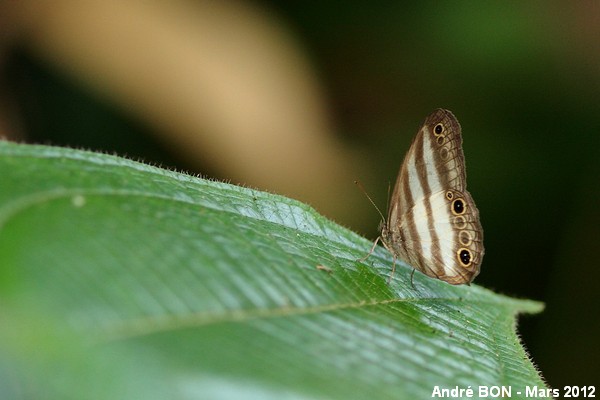
| Two-banded Satyr (Pareuptychia ocirrhoe (Fabricius, 1776)) |

|
|
Scientific name: Pareuptychia ocirrhoe (Fabricius, 1776) Common name: Two-banded Satyr Other names: Banded White Ringlet. Old scientific names: Cissia ocirrhoe, Cissia hesione. French name: Order: Lepidoptera Suborder: Rhopalocera Family: Nymphalidae Subfamily: Satyrinae Wingspan: 37 mm. Biotope: Primary tropical rain forests, secondary forests, woodland edges, road sides. Geographic area: Central America and South America in two separated geographical ranges, from Mexico in the north down to western South America as far as Peru and Bolivia for the first one, eastern South America, from Trinidad and Tobago, in Suriname, in French Guiana, in Brazil south to northern Argentina for the second one. Flight time: All year round. Number of generations : Caterpillar: Bright green with two small caudal pointed extensions and two short reddish horns on the head. Host plant: Poaceae of the Eleusine genus. |
The Pareuptychia genus includes 8 species with a rather large size and white wings marked with broad dark brown stripes. The upper side of Pareuptychia ocirrhoe's fore wings is white with a blackish brown area whose extent vary depending on sex and region. Males of the Central America and Pacific coast range show a wide marginal band extending to the inner edge without tapering. They also show a median band starting from the costal edge and ending at the discal cell. Females have the median band extending further backwards and they show some brown colour on the marginal area of the hind wings, better marked at the apex. The underside of the wings is marked with whitish and brown stripes with one apical eyespot on the fore wings followed by two other weakly marked eyespots. The hind wings show two large eyespots with two other weakly marked ones in between and another smaller one at the apex. The butterflies of the other geographical range, on the Atlantic side, have the marginal band which tapers posteriorly and the median band is very thin and very short, starting from the costal edge. Females have less brown colour on the upper side of the hind wings. The underside of the wings is similar but the brown stripes tend to be slightly wider. There is a very similar species, Pareuptychia hesionides. I have not found any document clearly explaining how to tell it apart from Pareuptychia ocirrhoe. |
| [To know more about the Two-banded Satyr] [Top] |

|
I have shot this picture in Saül while walking along the Roche Bateau footpath. Without any upper side view and without any detailed documentation nor experience, I have not been able to choose between Pareuptychia ocirrhoe and Pareuptychia hesionides. |